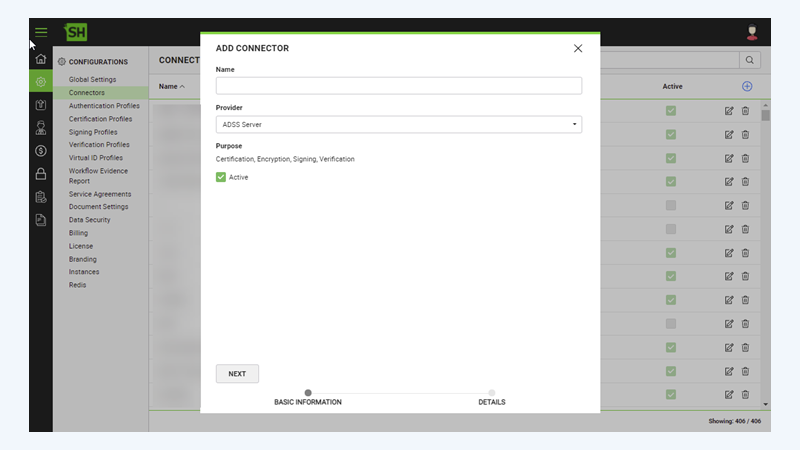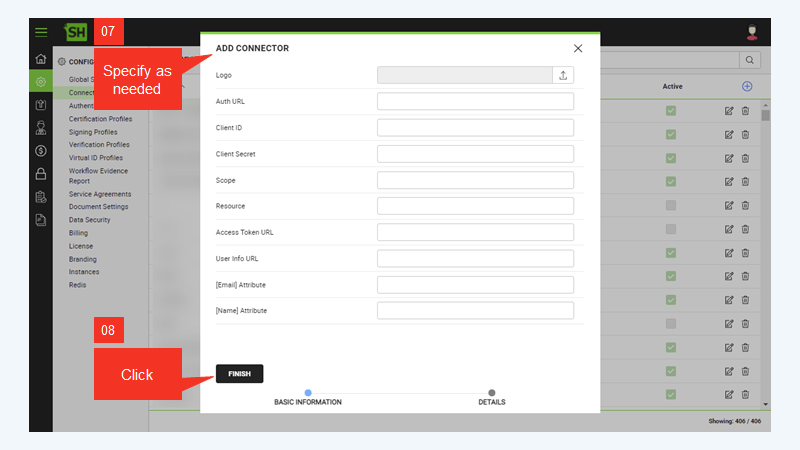Create an OAuth2.0 Connector
- The OAuth2.0 connector allows you to easily connect SigningHub with any third-party authentication service that supports OAuth2.0 protocol like Google, LinkedIn, SalesForce, and Facebook. The "Auth URL" provided in the connector will be used for identifying the third-party service configured in the connector and then authenticating the end users a the time of both logging into SigningHub and performing signatures.
Create an OAuth2.0 connector:

- From the left menu, click "Configurations".
- Click "Connectors" .
- From the top right corner of the connectors list, click
 .
.
The Add Connector dialog is displayed.

The Add Connector dialog is a step-wise wizard consisting of the following the steps for configuring the connector:
1) Basic Information
2) Details
On the Basic Information section:
- Type in a unique Name for the connector.
- Select "OAuth2.0" in the Provider field.
- Click Next.
The following image illustrates an example of information entered on the dialog.
On the Details section:

- Specify the fields as required by the third-party service; leave the rest empty.
- Click Finish.
The OAuth2.0 connector has been added and can be used in an authentication profile.
The following image illustrates the example information entered on the "Details" section of the dialog.
The following table describes the fields on the "Basic Information" section of this dialog.
|
Basic Information Section |
|
|
Fields |
Description |
|
Name |
Specify a unique name for this connector, i.e. My Google. This connector will be used in the configuration of Authentication Profiles. |
|
Provider |
Select the provider for this connector, i.e. "OAuth2.0". |
|
Purpose |
This field will display the purpose of the selected provider above, i.e. the purpose of "OAuth2.0" is "Authentication". |
|
Active |
Select to make this connector active. Keep the check box empty to make the connector In-active. An inactive connector cannot be configured in the Authentication Profiles. |
|
Next |
Displays the "Details" section. |
The following table describes the fields on the "Details" section of this dialog.
|
Details Section |
|
|
Fields |
Description |
|
Logo |
Select an appropriate image in the jpeg, jpg, gif or png format for the connector's logo that will be displayed on the login screen. |
|
Auth URL |
Enter the endpoint as provided by the third-party authentication server. For example, "https://accounts.google.com/o/oauth2/v2/auth" is for Google. |
|
Client ID |
Enter the registered client ID as provided by the third-party authentication server. By default, the text is masked with asterisks, you can click |
|
Client Secret |
Enter the client secret as provided by the third-party authentication server. By default, the text is masked with asterisks, you can click |
|
Scope |
Enter the scope if required by the third-party authentication server. If not required, leave empty. |
|
Resource |
Enter the resource value if required by the third-party authentication server. If not required, leave empty. |
|
Access Token URL |
Enter the endpoint as provided by the third-party authentication server for exchanging the authorisation code for an access token. For example, "https://www.googleapis.com/oauth2/v4/token" is provided by Google. |
|
User Info URL |
Enter the endpoint as provided by the third-party authentication server for returning the logged-in user information. For example, "https://www.googleapis.com/oauth2/v2/userinfo" is provided by Google. This is required by SigningHub for matching the returned email address in the database for the existence of the user. |
|
Email [Attribute] |
Enter the value as provided by the third-party authentication server for getting the value of Email Address from the User Info endpoint response. This field is mandatory for all third-party services and accepts only text (non-numeric) values. The value required in this field may vary for different third-party services. For example, "email" is requested by Google, and "mail" by "Azure Active Directory" |
|
Name [Attribute] |
Enter the value as provided by the third-party authentication server for getting the value of Name from the User Info endpoint response. . This field is optional for all third-party services. The value required in this field may vary for different third-party services. For example, "name" is requested by Google, and "displayName" by "Azure Active Directory". |
|
Finish |
Creates a new connector using the information entered on the dialog. |
|
|
|
See Also
- Create a LinkedIn Connector
- Create a Google Connector
- Create a OneDrive Connector
- Create an ADSS Server Connector
- Create a Clickatell Connector
- Create a Twilio Connector
- Create a Worldpay Connector
- Create a Stripe Connector
- Create an SMTP Server Connector
- Create an Active Directory Connector
- Create a Dropbox Connector
- Create a Salesforce Connector
- Create a SAML IdP Connector
- Create a Google Drive Connector
- Create a HubSpot Connector
- Create an Office 365 Connector
- Create an ADFS Connector
- Create a Maxmind GeoIP Connector
- Create a Firebase Connector
- Create a Freja Mobile Connector
- Create a Freja eID Connector
- Create an Azure Blob Connector
- Create an Azure Active Directory Connector
- Create a Bank ID Connector
- Create a Captcha Connector
- Create an SMS Connector
- Create an itsme Connector
- Create a T1C Connector
- Create an SSLCommerz Connector
- Create a File Scanning Connector
- Create a CSC Connector
- Create an OIDC Connector
- Edit a Connector
- Delete a Connector
- Search a Connector



